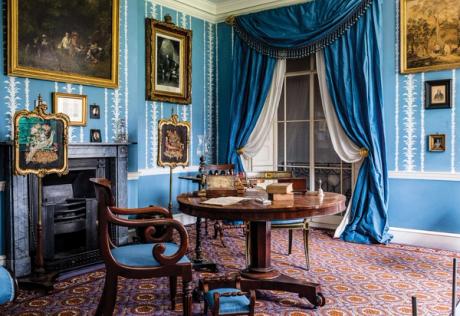
There is more than a bit of light spring cleaning going on at the Museum of the Home—formerly the Geffrye Museum—a much-loved institution occupying a row of beautiful Georgian almshouses in Hoxton, east London. As soon as Twelfth Night has passed, staff will begin dismantling seven of the museum’s most popular rooms, packing away hundreds of pieces of furniture, ornaments, pieces of crockery, toys, rugs, a 1970s white plastic telephone and even a 1990s mini CD player.When The Rooms Through Time reopen next summer, they will be transformed to better reflect the setting of the museum in a vibrant, multicultural district of London, where Bengali, Afro-Carribean, Irish and other originally immigrant communities, artists, craft workers and students are just about withstanding the onslaught of developers.The Rooms Through Time began when the almshouses were converted into a museum in 1914 with a collection of furniture intended to inspire good craftsmanship. The original rooms are a suite of spaces in the Georgian buildings dressed as domestic interiors across four centuries. But the rooms now being dismantled are the most recent, created in the 1990s extension. “They’ve now been there for more than 20 years and they are looking a bit old—and not in a good way,” says the museum’s curator Louis Platman.From Jacobean to Edwardian, the rooms are full of fine furniture, textiles, silver, porcelain and glass. But, across the centuries, they have one thing in common and one common problem: they are overwhelmingly white and middle class, Platman says. The effect is most striking in the 18th- and 19th-century rooms, with their mahogany tables, velvet armchairs and silver punch bowls. But the issue remains in the 1937 room, where the caption explains that “a maid is coming to collect the resident’s half-eaten meal and dust the room”.If our audiences don’t like the changes we’re making to the rooms, they’ll lose no time in letting us knowLouis Platman, Museum of the Home curatorThe museum’s 2021 basement gallery displays a far wider selection of furnishings from a much broader social and ethnic range—with the inclusion of real recorded voices. The contrast between the displays became yawningly obvious, and it is noticeable that visitors chat freely downstairs but tend to maintain a traditional library silence upstairs.“We are going to fix that,” Platman says. “We will be adding music and voices to animate these spaces.” The scene-setter will be, as it is now, a late 19th-century room. But it is now subject to a redisplay that will tell the story of the ayahs, the Indian nannies who came back to England with many colonial families. The soundtrack will be their voices as they sing the songs of their villages, songs which were sung in a strange, cold and wet country to lull English children to sleep.The inspiration for the redisplay came from the museum’s 1978 room, recreating the remembered front room of Michael McMillan—a London-based writer and dramatist with Caribbean heritage—with its giant radiogram, flowery carpet and searingly bright orange wallpaper hung with china plates and family photographs. It included many objects donated by McMillan’s Afro-Caribbean family and proved to be the best loved of all the 20th-century rooms, sparking animated conversation among visitors who remember just such front rooms which were usually off limits except on special occasions, even in small houses and flats.Local communities including Jewish, Bengali, Irish and Vietnamese are closely involved in creating the new displays. The design for the 1950s Irish bedroom has already been changed after an exhibition at the London Irish Centre where nobody could remember the luxury of a fitted carpet—so rugs on dismal green or brown lino it will be.Platman says the other question regularly posed by visitors is why there are no kitchens or bathrooms, and this will be corrected in several of the new rooms. The Vietnamese room will centre on a family meal being prepared—with sounds and smells—and local people are growing vegetables and herbs for the conservatory in the background. The last of the rooms has, until now, shown the glamorous loft apartment of a gay couple on the eve of the millennium: it will remain a gay home, but the elegant space will be chopped up into several much more cramped spaces, reflecting the current reality of renting in London.The 1911 room will recreate the tenement home of Jewish textile workers preparing for Friday night dinner in the Rothschild buildings, an east London housing block well remembered locally and demolished in the 1980s. It is the most personal for Platman, whose father’s family were immigrants from Poland and whose surname means a presser in the textile trade.The museum is free admission and the many repeat visitors take a very engaged approach to its fortunes, in an area of London with a centuries-long history of radical politics. There was uproar over aproposal to demolish a derelict Victorian pub on the edge of the site in the 2021 development, and in the end it was retained as a charming museum café—currently closed, but hoping to reopen soon when a new operator is found.The row rumbles on about Robert Geffrye, the wealthy merchant who founded the almshouses, though he had no connection with the museum or its collections. His statue—an early-20th-century copy of the original—still stands above the Georgian main door. As a nearby plaque explains, repeated in the almshouse chapel where his memorial is displayed, much of Geffrye’s fortune was built on human misery, from investments in the slave-trading East Africa Company. The local community voted that the statue should go, but it got caught up in the controversy over the toppling of the statue of Edward Colston into Bristol Harbour and the government’s subsequent “retain and explain” directive on such controversial works. The trustees have promised this year to revisit the question of keeping the statue on site but in a less prominent position.“We are very aware that everything we do here is closely studied by our audience, and rightly so,” Platman says. “If they do not like the changes we are making to the rooms, they will lose no time in letting us know.”The Museum of the Home’s 1630-1830 Rooms Through Time remain on display while a series of new 20th-century rooms will open in summer 2024


























